Hunting for moss in Shennongjia: Anything Can Be Found Here!
Updated:2024-07-10 Source:China National Geographic Explore
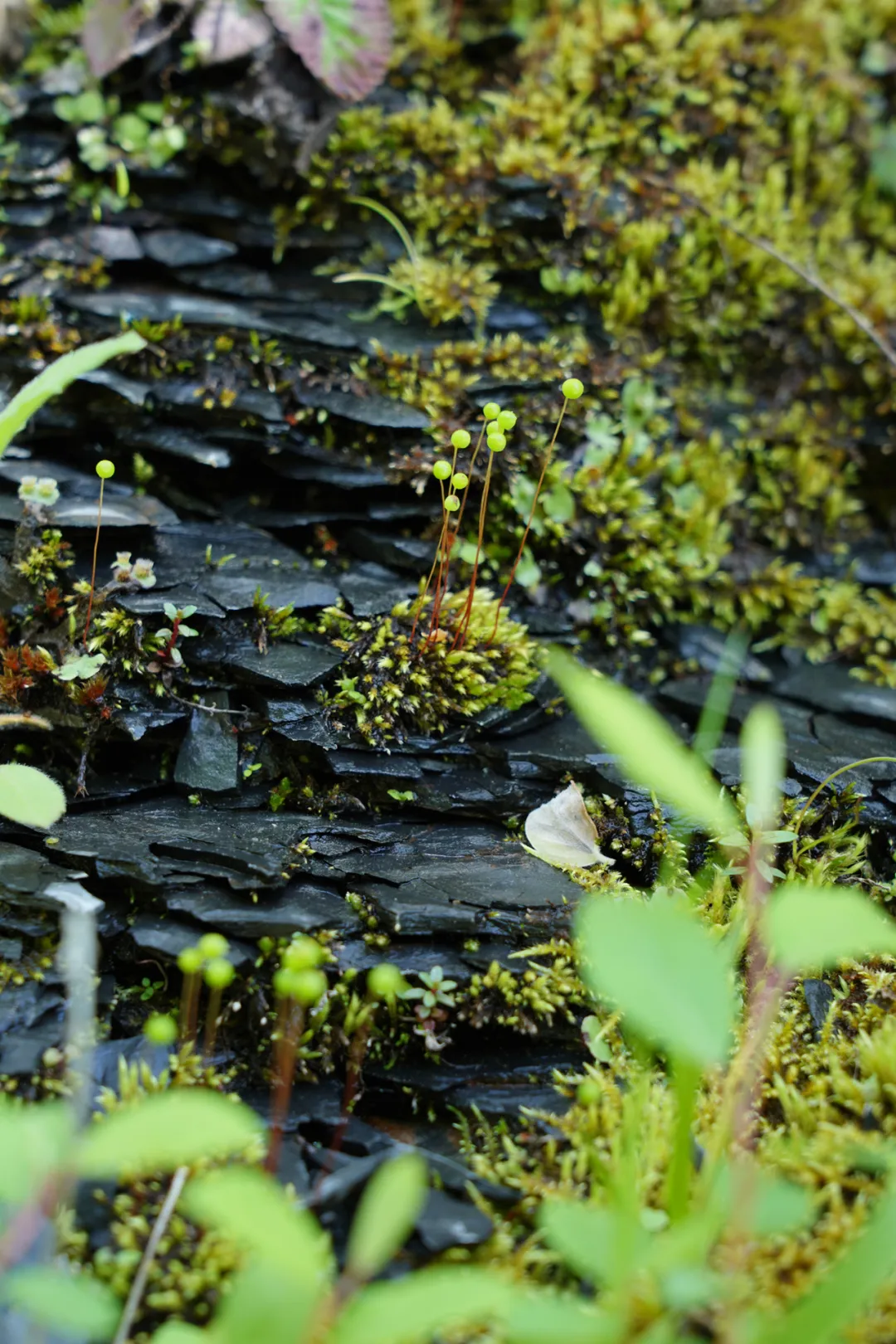
1
"Moss hunters" are on the move!
Originating in the middle of the 17th century, the occupation of "plant hunters" refers to Western explorers and naturalists, like keen hunters, who explored every corner of the world and looked for, collected, and brought back new and valuable plants to show them to the world. The work of plant hunters not only satisfied the curiosity of the people at that time but also promoted the development of plant taxonomy and even plant science.
In an era of advanced technology and increasingly rigorous scientific research, the discovery of new plant species, especially bryophytes, which are small and difficult to recognize, has become a challenge. Today's moss taxonomists must rely on solid professional knowledge and venture deep into the forest with great caution and bravery to make some discoveries. They have also become a new generation of "moss hunters" who are responsible for conserving mosses.

2
Shennongjia: Moss Paradise
Shennongjia, a mysterious region in the heartland of China, is located south of the Qinling Mountains and at the junction of the Daba Mountains and the Wu Mountains. In ancient times, the Shennongjia area used to be a vast ocean, which gradually evolved into a multi-level plateau over a long period of time during the orogeny. The towering mountains have created distinct vertical climatic zones, resulting in complex climatic conditions in the region.
The precipitous landscape and changing climate provide an excellent environment for plants to survive and thrive, and the dense forest provides a favorable environment for other species to flourish. In these dense forests, different communities are closely linked and reproduce for generations, giving rise to a unique and unparalleled ecosystem. Also, due to the rugged and difficult terrain, the Shennongjia area has a large no-man's land and has become a treasure trove of precious species. The humid and cool climate of Shennongjia, combined with the complex environment of cliffs, dense forests, and rich humus, has also shaped the most favored habitat for mosses, creating a breathtaking moss wonderland.
To better understand the current status of the mosses in the Shennongjia area and to unveil the diversity of the mosses in this famous natural habitat, two moss-hunting teams organized by the Institute of Botany, the Chinese Academy of Sciences (short for the Institute of Botany) in Beijing set out from the south (Fujian) and the north (Beijing) respectively and assembled in the Shennongjia area and went deep into the secret forest to make an extraordinary scientific expedition.
3
"The hunters" and "the order for arrest"
On the eve of the departure of the researchers, a message was posted in the WeChat group of the Moss Group of the Institute of Botany:
"For the members who are going to Shennongjia, it is suspected that there are new species of Orthotrichum Hedw. in Shennongjia, and the above show information on the collection of these suspected species of mosses! Please collect more twisted leaf specimens! The leaves are twisted! The leaves are twisted! The leaves are twisted!"
(Note: This genus belongs to Orthotrichum Hedw. and is commonly found on trees. In the following text, this genus will be referred to as the new species or suspected new species for brevity.)
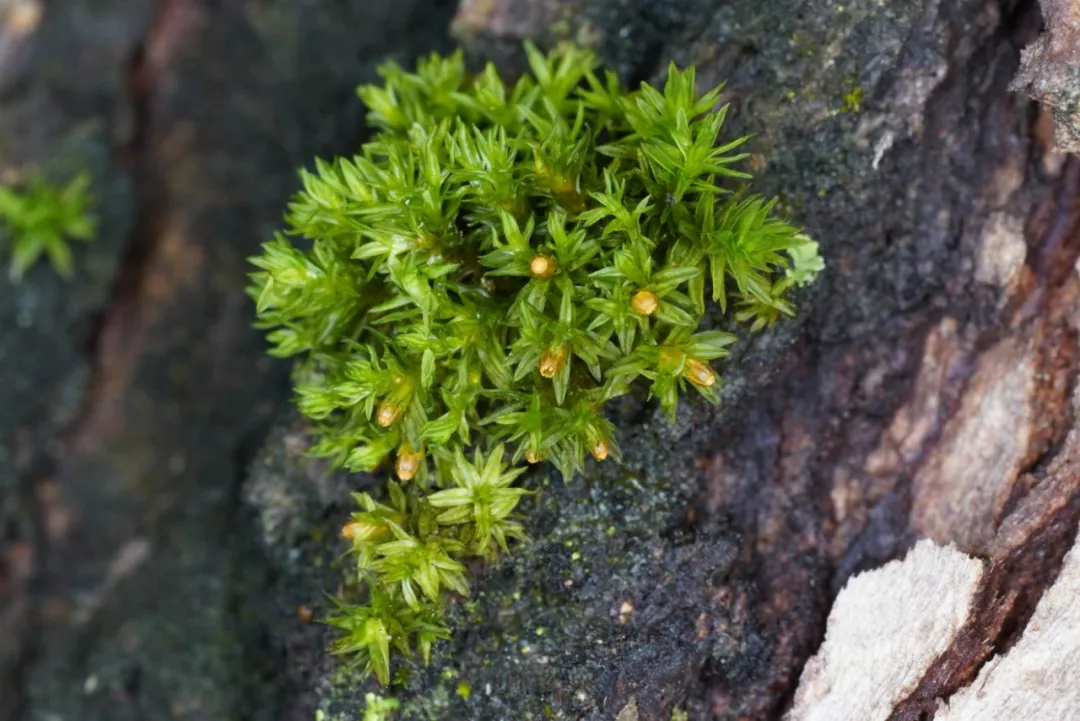 Orthotrichum Hedw.(Photo by Luo Lian)
Orthotrichum Hedw.(Photo by Luo Lian)The person who posted those pictures was Wang Qinghua, a specialist in the classification of Orthotrichum. The screenshot she posted showed that seven specimens of a suspected new species of Orthotrichum Hedw. had been collected during a field trip to Shennongjia in September 2023. This news was like an "order for arrest" and made the members of the group very excited.
It is necessary to collect a sufficient amount of specimens to study the morphology and molecules of the new species, thus providing sufficient evidence to certify it. However, of the more than 1,000 specimens collected in Shennongjia last time, only seven were suspected to be new species and each had only a few plants. The researchers received the order and set off. The task of "census" became interesting, full of challenges and expectations.
As they entered the Shennongjia area, the temperature became cooler, and the scenery on both sides of the road gradually changed: the mountaintops and tree canopies are lush and verdant, and the bare tree trunks, riverbanks, and roadbeds are capped by green moss. The moss intertwined with the trunks adds primitive charm to the dense forest. We could not help but think of ancient times when moss might be the dominant force on the land billions of years ago. It gently enveloped everything, making even lifeless, angular walls and crusts become fluffy and full of vitality. Here, the unchecked growth of moss resembled an endless, exquisite carpet, leading us toward the true realm of the plant kingdom.
The first place they visited was Guanmen Mountain, which was also the only location where suspected new species of moss were previously discovered during this trip. Although it hadn't rained in Shennongjia recently, the rock surfaces and tree trunks appeared slightly dry, yet the area was still covered with clusters and patches of moss.
"Orthotrichum Hedw.!"
Luo Lian, an experienced member, immediately recognized the suspected "wanted" objects from a tree trunk at the entrance. She had made many field trips and was familiar with the characteristics of Orthotrichum Hedw. Even so, she could not conclude that this was the "wanted" new species of Orthotrichum Hedw. based on visual observation alone. Without a microscope, it was impossible to see all the morphological features during the collection process. Veterans could roughly tell the genus name, but species level identification was largely a matter of guesswork. Therefore, they could only extend their "wanted" targets to include all suspected genera. This kind of "blind collection" by luck is a "pain point" of moss fieldwork.
Because of the small size of the moss, it was difficult to collect specimens in all aspects. Firstly, species identification of moss could not be done accurately at the collection site, and species names could only be determined with a microscope. Secondly, recording the pictures of moss specimens required more care and attention than recording those of larger vascular plants, and specialized equipment was needed to obtain high-resolution and comprehensive pictures.
A variety of different moss species grew together. Without careful observation, it was easy to collect different species at the same time, which could lead to problems in subsequent identification. In the process of collecting moss, both close observation and a broad field of vision were required. As they grew all over the place, it was difficult to scan all the moss along a route even if you had eight eyes. So even when an interesting species was close at hand, the team members would take no notice.
As walking down the trail, they found and collected dozens of bryophytes, such as Orthotrichum Hedw., Ulota D. Mohr, Meteorium Dozy & Molk, Polytrichum Hedw., Plagiomnium T. J. Kop., and Fabronia Raddi., with a focus on collecting more than 10 specimens of Orthotrichum Hedw.
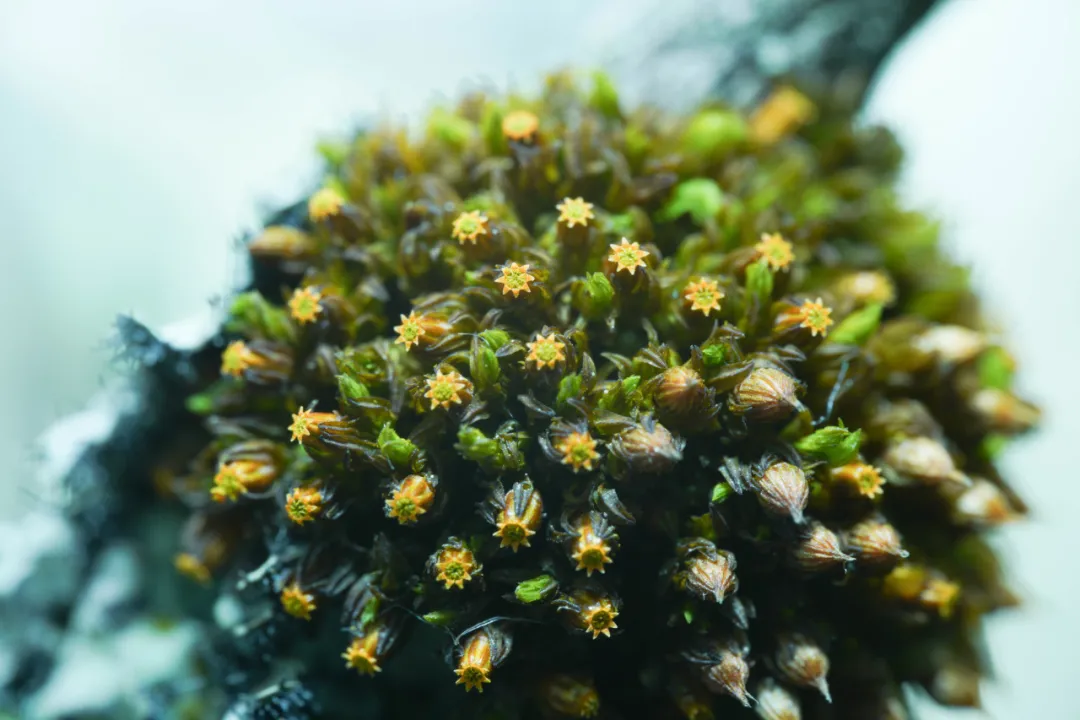 The specimens of Orthotrichum Hedw. (Photo by Luo Lian)
The specimens of Orthotrichum Hedw. (Photo by Luo Lian)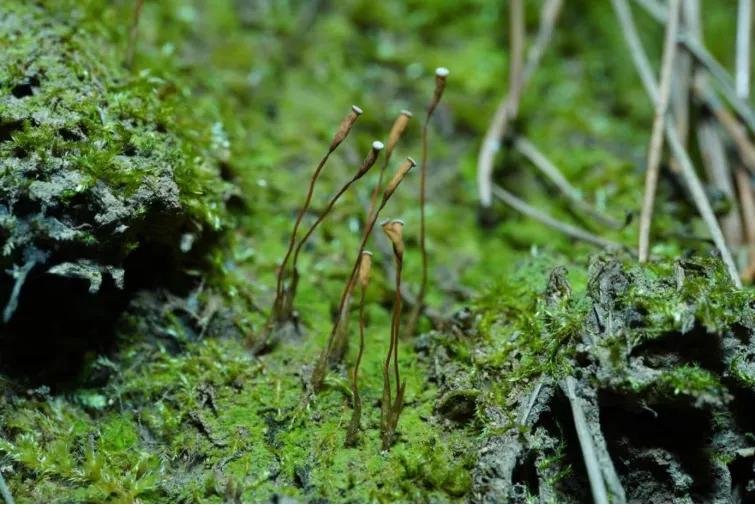 Pogonatum spinulosum Mitt. with severely degraded gametocytes, which can be recognized with the naked eye. (Photo by Luo Lian)
Pogonatum spinulosum Mitt. with severely degraded gametocytes, which can be recognized with the naked eye. (Photo by Luo Lian)On this trip, was it possible to pick up a new species of "wanted" moss? The answer was hidden in small blind boxes of newspaper, so we would have to wait for the results of the identification.
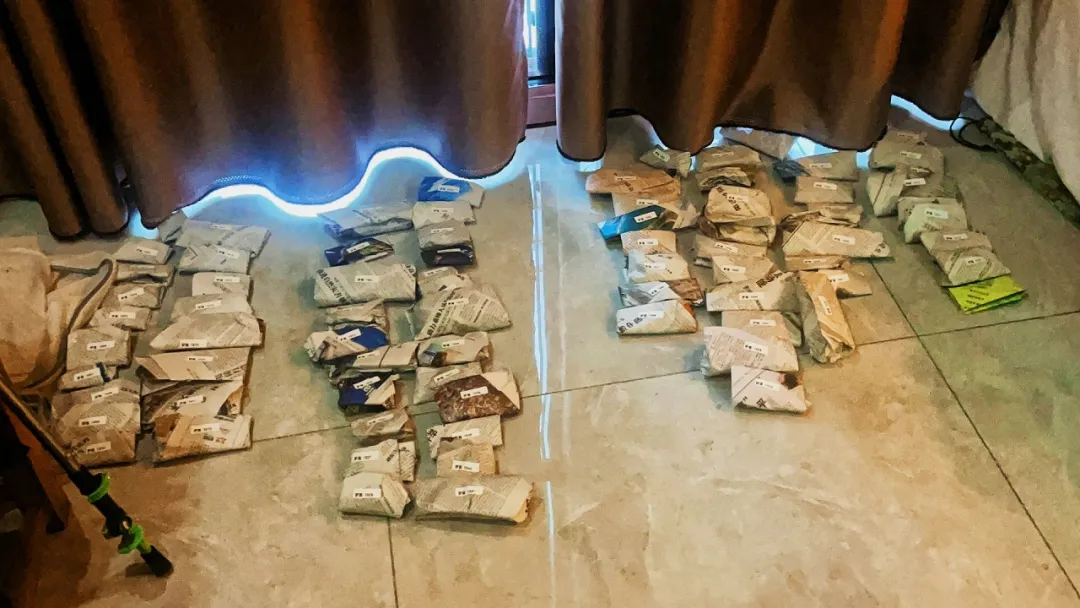 Team members are organizing the collected specimens. (Photo by Zhao Yuanjin)
Team members are organizing the collected specimens. (Photo by Zhao Yuanjin)4
Encountering the golden snub-nosed monkey in the Golden Monkey Ridge
Shennongjia is not only home to rare plants but also one of the main habitats for Sichuan golden snub-nosed monkeys. During the collection process at the base, it was found that many mosses were attached to branches in the forest along streams, which showed that various vegetation could provide the mosses with ample fresh growth material. Moss generally grows at the fork of thin and dense bamboo branches, so if you don't look carefully, you might miss them. Thanks to the keen eyesight of the moss hunters, they could spot them as soon as they looked over the roadside.
Another collecting site, Golden Monkey Ridge, is a well-preserved primary forest, where the hiking route is characterized by dense forest formed by tall trees and gurgling streams. Climbing along the streams, you could collect bryophytes while looking for interesting species.
Suddenly, Luo Lian, a team member, stopped at a large moss-covered rock with a sign which read "Golden Monkey Listening to the Waterfall". She looked closely at it, caressing the moss on its surface while murmuring, "This may be what I am studying… Oh! There are quite a few sporophytes!
A few young people in the same team went up to take a closer look. On the seemingly ordinary rock, there was a large number of pale golden plants with a textile-like luster. The plants were as thin and soft as a golden snub-nosed monkey's hair with a number of brown granules in between, which were sporophytes that could easily be mistaken for debris.
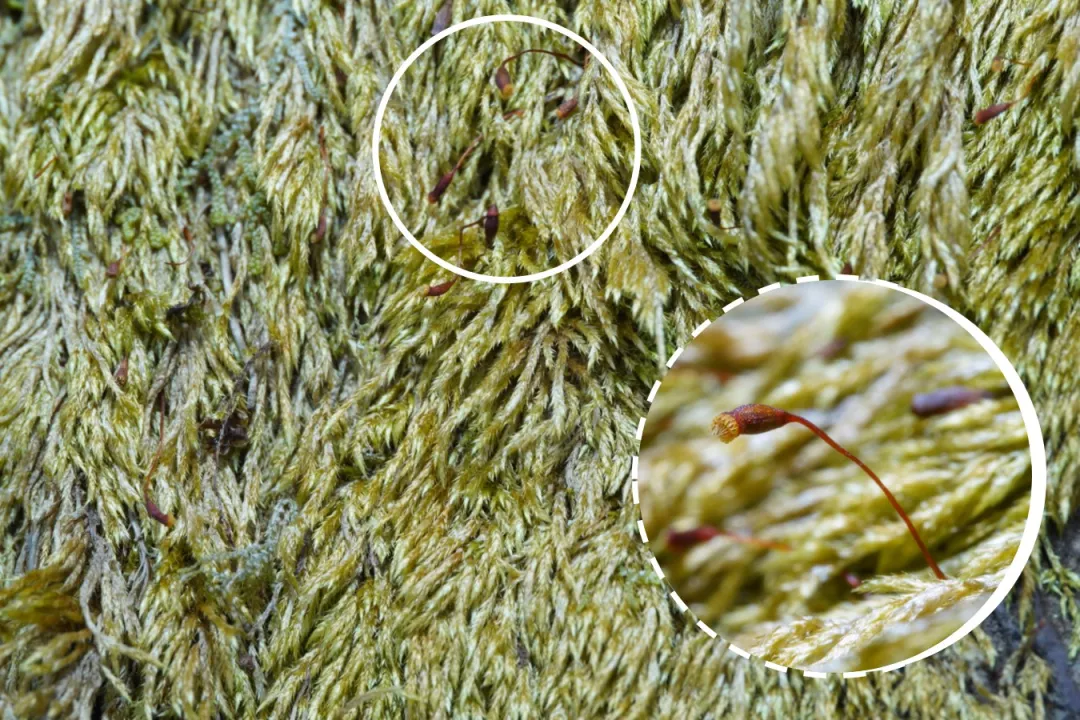 Wijkia hornschuchii(Dozy & Molk.) H.A. Crum (Photo by Luo Lian)
Wijkia hornschuchii(Dozy & Molk.) H.A. Crum (Photo by Luo Lian)The important basis for the classification of moss lies in their sporophyte characteristics, and their different forms can serve as rigid indicators for the identification of many species. When collecting specimens, plants with sporophytes are considered more valuable. For some moss species, sporophytes are not commonly seen, and finding plants with abundant sporophytes is thrilling for moss hunters.
The large rock suddenly came to life, like a golden monkey emerging from its hiding place. The team members worked together, meticulously recording every detail and carefully collecting and wrapping the materials.
Although the moss hunters did not encounter golden snub-nosed monkeys, the real national treasure, they did find their own treasure. Their collection work was truly fruitful!
5
Fairyland: The Peat Fairy
At higher altitudes, the temperature drops sharply. Moisture gathered on rocks, bamboo tips, grass tips, and mosses that were good at preserving water. During the collection process, a gentle squeeze would cause water to drip out. Unlike mosses, most liverworts are slender, fragile, and flaky, closely adhering to the substrate. They tend to break and shatter when they are short of water. Under heavy fog, they appear juicy, and their leaves stretch out, which makes them easy to identify.
At Banbiyan Rock, a scenic spot, on the mountaintop, the research team collected various bryophyte specimens belonging to multiple genera, including Riccardia Gray, Metzgeria Raddi., Lejeunea Lib., and Frullania Raddi. These specimens provided valuable materials for researchers to conduct further explorations. However, as they descended to the mountain's midsection and went deeper into the dense and dark forest, they encountered a completely different scenery.
A bryophyte fairy was hidden here. She is Sphagnum squarrosum Crome, a national second-grade protected wild plant. Known as the "living stone of the plant kingdom", an "effective ecosystem engineer", and the "sponge baby" of wetlands, she stands out as a renowned celebrity in the low-key world of bryophytes. Due to her ability to maintain wetland ecosystems and her capacity for carbon sequestration and storage, she has emerged as a shining star in the field of carbon cycle research today, fascinating scientists worldwide.
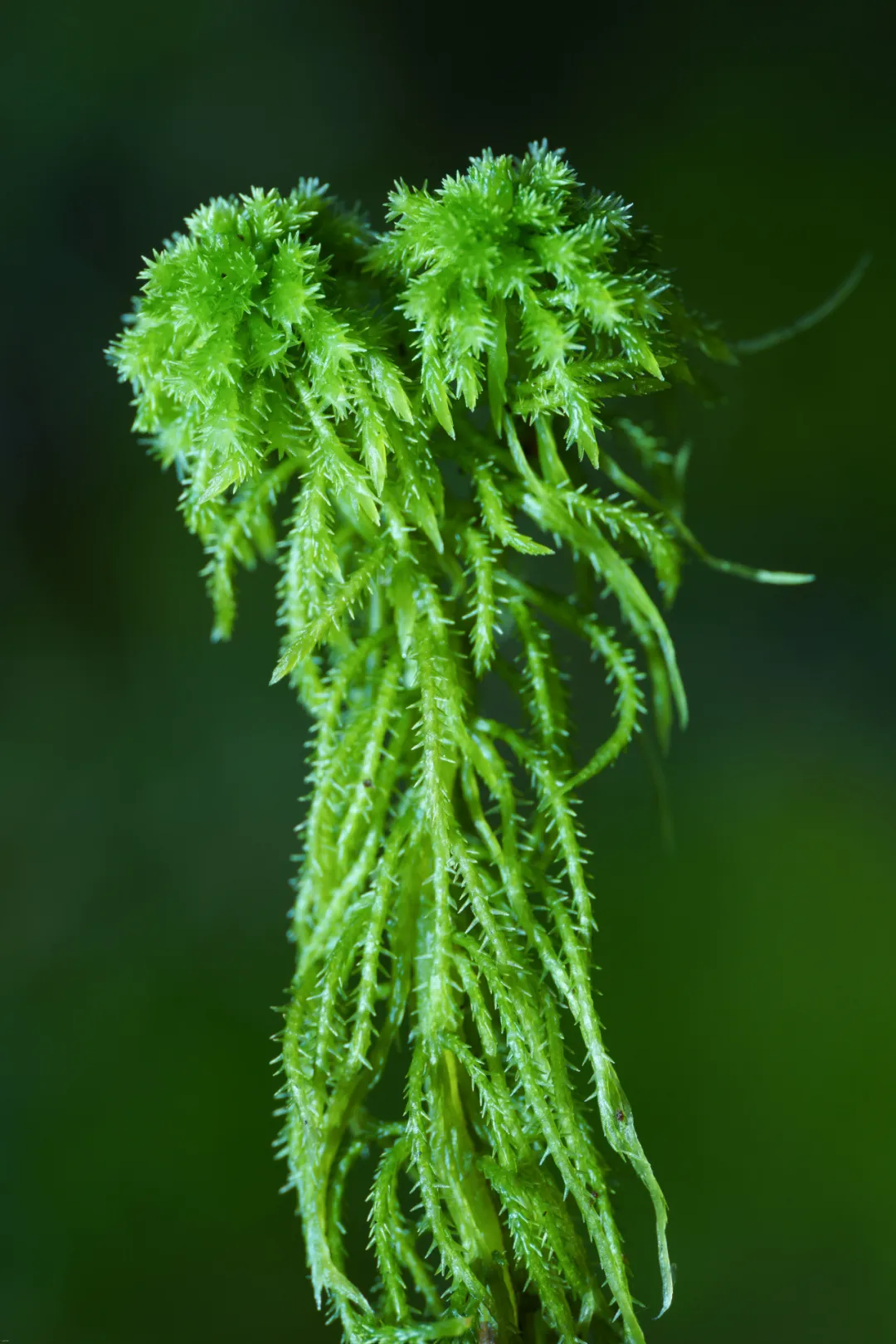 Sphagnum squarrosum Crome with intertwined branches (Photo by Luo Lian)
Sphagnum squarrosum Crome with intertwined branches (Photo by Luo Lian)Because of its mundane name, you may believe that it exists in muddy swamps and looks ordinary. However, the plant is stunningly beautiful when you see it in person.
Beneath the bamboo groves and beside streams, Sphagnum squarrosum Crome grew densely, resembling a green velvet carpet adorned with subtle patterns from afar. When sunlight filters through the bamboo leaves and falls upon this velvet expanse, it seems as if gold is being sprinkled upon it. Upon closer inspection of the plant, you will discover its enormous "crown" (the clustered short shoots atop) that is like blooming green peonies. Its slender branches droop gracefully along the stem, like a fairy who wears green robes, exhibiting an ethereal elegance and tranquility. It is detached from worldly affairs!
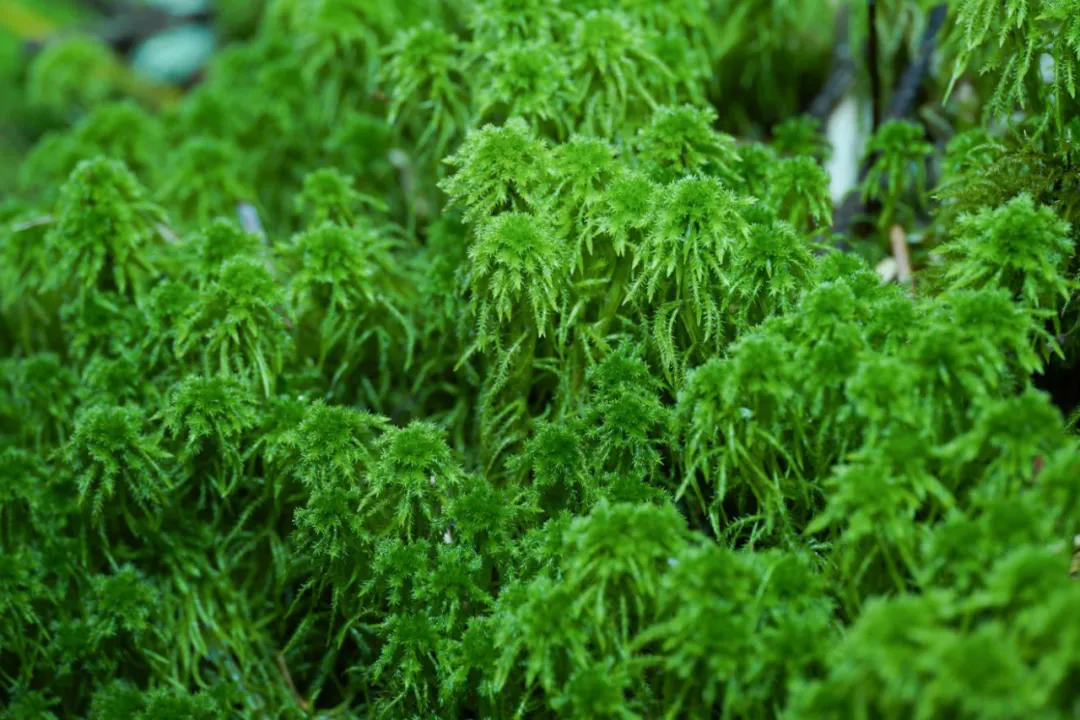 Sphagnum squarrosum Crome population (Photo by Luo Lian)
Sphagnum squarrosum Crome population (Photo by Luo Lian)6
A journey for light
Have you ever seen light?
It's the beacon of hope in the dark and the source of life's growth.
An inconspicuous and delicate type of moss, to thrive in places devoid of sunlight, has evolved a remarkable and efficient light-gathering system. Because of its luminous nature, scientists named it Cyathodium Kunze.
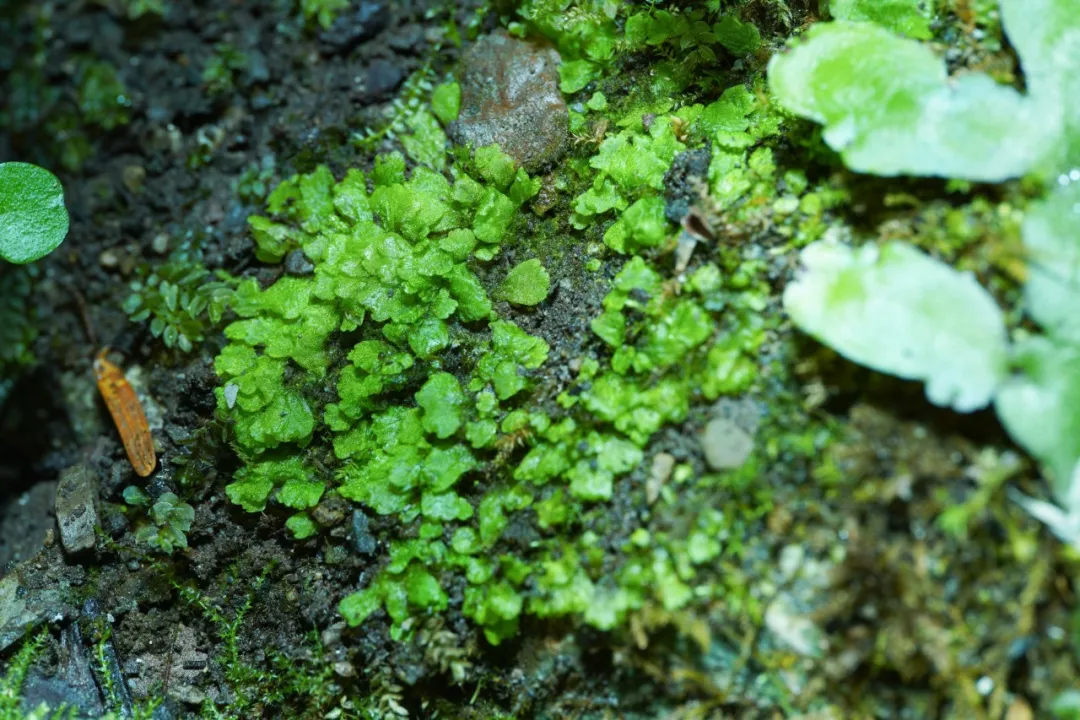 Cyathodium Kunze (Photo by Luo Lian)
Cyathodium Kunze (Photo by Luo Lian)Cyathodium Kunze has a simple and flat structure, and to differentiate between its stem and leaf is impossible. The moss thrives in damp and shadowy environments, which are usually unfavorable for photosynthesis. However, its extraordinary chloroplasts move towards light in its cells, so they can capture light as much as possible. These clustered chloroplasts and cellular structures, resembling tiny lenses, reflect light, making the moss shine and conspicuous in the dark.
In the Gallery Valley of Hongping Town, there is a tiny cave beside a stone bridge by a stream. A ray of green light gleams at the mouth of the cave. An observant hunter, sensing the presence of its quarry, leans in to take a closer look at the moss, which is the size of a coin but stands out because of its fluorescent green color.
That is Cyathodium Kunze.
Since this intriguing species is rare in the north of the Yangtze River, its appearance left the expedition team members breathless. Later, beneath a wooden table by a waterfall, where tourists could take a rest, they stumbled upon a vast expanse of Cyathodium Kunze, which causes a ten-square-meter rock wall to reflect green light. They couldn't believe it when they saw this green color. How spectacular Cyathodium Kunze population was!
The moss, seemingly fragile enough to shatter at a touch, survived in the spot where tourists made frequent visits. It grew towards the light and thrived.
 Tiny and delicate Cyathodium Kunze (Photo by Luo Lian)
Tiny and delicate Cyathodium Kunze (Photo by Luo Lian)Here, the team collected several valuable specimens for subsequent classification and identification. Through scientific research, they might gain a deeper understanding of the mysterious light-gathering mechanism of these fairy-like mosses.
7
Elusive Buxbaumia Hedw.
Every biological group has a few "legends" that are famous but elusive, but the most mysterious one among bryophytes is Buxbaumia Hedw. Its mystery, rarity, and its high demand for living environment make this plant elusive. Since the rare plant always appears in uncharted areas, Jia Yu, a specialist in bryophytes, once described it as a "recluse".
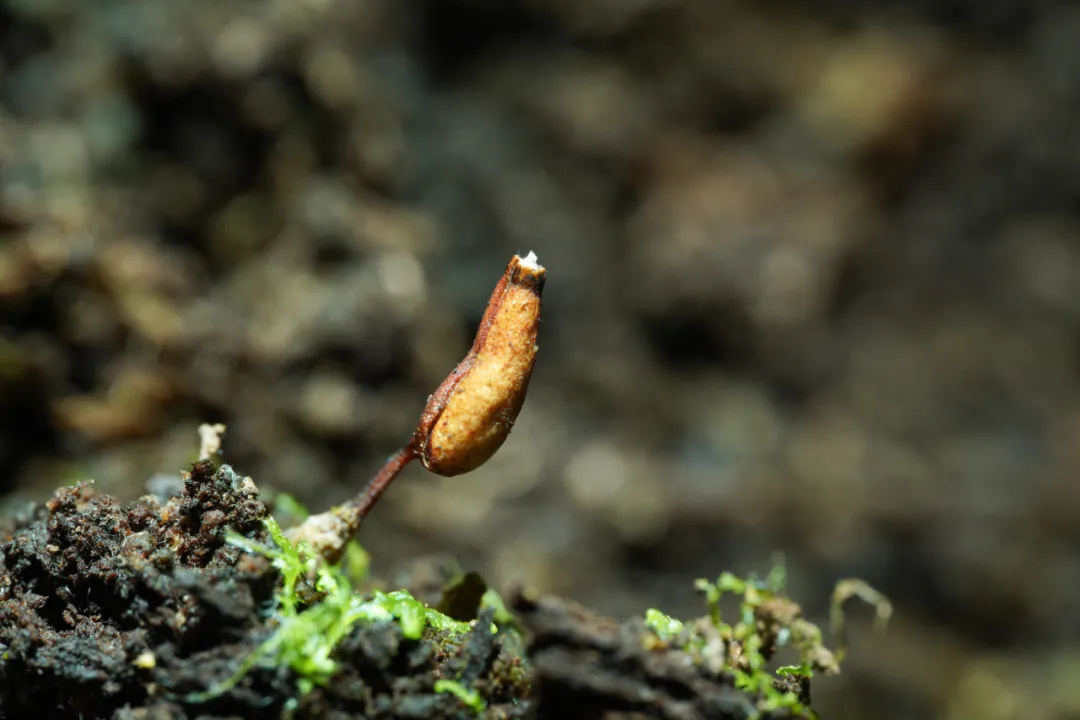 Buxbaumia Hedw. (Photo by Luo Lian)
Buxbaumia Hedw. (Photo by Luo Lian)If consulting the Chinese history books on bryophytes, you will find that there are merely 12 kinds of Buxbaumia Hedw. in the world, with three distributed in China. In China, the plant can only be found in Jilin, Shaanxi, Sichuan, Yunnan, Xizang, and Taiwan, and was never found in the Shennongjia area in Hubei Province.
However, anything may be found in Shennongjia.
Experienced moss hunters know that Buxbaumia Hedw. can only be found on fallen trees in remote, pristine forests. Yet, to their astonishment, they spotted several tiny specimens of the plant on roadside rotting wood, which was against common knowledge. Its appearance was not only a significant discovery during this survey but also the first record in the Shennongjia area and even in the entire Hubei Province.
 Three samples of Buxbaumia Hedw. collected from rotten wood (Photo by Luo Lian)
Three samples of Buxbaumia Hedw. collected from rotten wood (Photo by Luo Lian)8
From particulars to generals
During the 9-day expedition, they got a total of 649 moss specimens, took thousands of photos, collected bryophytes such as Polytrichum Hedw., Orthotrichum Hedw., Ulota D. Mohr, Philonotis fontana Brid., Meteorium Dozy & Molk., Bartramia Hedw., Myuroclada Besch., Cryphaea D. Mohr & F. Weber, Plagiomnium T. J. Kop., Hypopterygium Brid., Metzgeria Raddi., Riccardia Gray, Frullania Raddi., Lejeunea Lib., Pallavicinia Gray, and Pellia Raddi., and made major discoveries such as a new distribution of large populations of Cyathodium Kunze and Buxbaumia Hedw.
Mosses are small, but if you take a close look at them, you may feel pleasantly surprised. On a small piece of land no larger than a palm, there may be several different kinds of mosses. Some are lying on the ground, some have delicate spores with dewdrops hanging on them, and all of them are very different and lovely. During the collection process, you often need to lie down, crouch down, lean close to the ground, and look carefully. In those few minutes, you are like a drop in the ocean, truly merging with nature, talking with the mosses, and forgetting about time and space.
A glimpse of the vast world and all creatures within a tiny space
I would like to dedicate this paper to the older generation of "moss hunters", and I hope that the younger generation will usher in a new era for China's research on bryophytes based on the excellent work of their predecessors!
Written by: Zhao Yuanjin, Wang Qinghua Editted by: Yi Yi
Copyright Shennongjia National Park
Address:36 Chulin Road, Muyu Town, Shennongjia Forestry District, Hubei Province 鄂ICP备18005077号-3
Address:36 Chulin Road, Muyu Town, Shennongjia Forestry District, Hubei Province 鄂ICP备18005077号-3
Email:2673990569@qq.com
Phone:0719-3453368
Phone:0719-3453368


TOP

